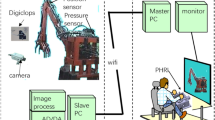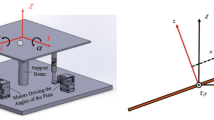Abstract
In this paper, an initial states iterative learning control algorithm is proposed for control of the ballistic endpoint displacement in three-dimensional space, where the target is moving and the projectile experiences system uncertainties. The characteristics of the three-dimensional ballistic process are formulated and explored, and the learning algorithm is proposed in the spatial domain. The algorithm consists of two parts. First, the initial speed and angles are iteratively learned to make the projectile attain a fixed position. Second, the shooting time is learned to tune the arrival time of the projectile. Since the dimensions of the solution space are larger than that of the task space, three control manners, including shooting speed, shooting angle and their combination, are researched respectively. Through rigorously analyzed, it is proved that the algorithm is convergent and the multiple initial states can be adjusted simultaneously. Finally, an example of practical cannonball projection is presented to verify the effectiveness of the proposed algorithms.











Similar content being viewed by others
References
Ahn HS, Chen YQ (2007) State-dependent periodic adaptive disturbance compensation. IET Control Theory Appl 1(4):1008–1014
Antnio CC (2014) A memetic algorithm based on multiple learning procedures for global optimal design of composite structures. Memetic Comput 6:113–131
Chen YQ, Wen CY, Xu JX, Sun MX (1998) High-order iterative learning identification of projectile’s aerodynamic drag coefficient curve from radar measured velocity data. IEEE Trans Control Syst Technol 6(4):563–570
D’Avella A, Cesqui B, Portone A, Lacquaniti F (2011) A new ball launching system with controlled flight parameters for catching experiments. J Neurosci Methods 196:264–275
Deakin MAB, Troup GJ (1998) Approximate trajectories for projectile motion with air resistance. Am J Phys 66(1):34–37
Dou L, Dou J (2011) Three-dimensional large landing angle guidance based on two-dimensional guidance laws. Chin J Aeronaut 24:756–761
Feng L, Ong Y, Tan A, Tsang LW (2015) Memes as building blocks: a case study on evolutionary optimization + transfer learning for routing problems. Memetic Comput 7:159–180
Feng Y, Huang Y, Huang B (2014) Trajectory extrapolation based on fitted ballistic coefficient. J Projectiles Rockets Missiles Guid 34(2):117–119
Freeman CT, Cai Z, Paul ERA (2011) Iterative learning control for multiple point-to-point tracking application. IEEE Trans Control Syst Technol 19(3):590–600
Hernandez-Saldana H (2010) On the locus formed by the maximum heights of projectile motion with air resistance. Eur J Phys 31:1319–1329
Hu H, Zhao YP, Guo YJ, Zheng MY (2012) Analysis of linear resisted projectile motion using the Lambert W function. Acta Mech 223:441–447
Huang D, Xu JX (2011) Steady-state iterative learning control for a class of nonlinear PDE processes. J Process Control 21(8):1155–1163
Huang D, Xu JX, Li X, Xu C, Yu M (2013) D-type anticipatory iterative learning control for a class of inhomogeneous heat equations. Automatica 49(8):2397–2408
Huang D, Xu JX, Venkataramanan V, Huynh TCT (2014) High-performance tracking of piezoelectric positioning stage using current-cycle iterative learning control with gain scheduling. IEEE Trans Ind Electron 61(2):1085–1098
Meng D, Jia Y, Du J, Zhang J (2014) On iterative learning algorithms for the formation control of nonlinear multi-agent systems. Automatica 50:291–295
Moore KL, Ghosh M, Chen YQ (2007) Spatial-based iterative learning control for motion control applications. Meccanica 42:167–175
Padhi R, Chawla C, Das PG (2014) Partial integrated guidance and control of interceptors for high-speed ballistic targets. J Guid Control Dyn 37(1):149–163
Palmer G (2005) Physics for game programmers. Springer, New York
Parker GW (1977) Projectile motion with air resistance quadratic in the speed. Am J Phys 45(7):606–610
Salama MA, Hassanien AE, Revett K (2013) Employment of neural network and rough set in meta-learning. Memetic Comput 5:165–177
Singh UK, Padmanabhan V, Agarwal A (2014) Dynamic classification of ballistic missiles using neural networks and hidden Markov models. Appl Soft Comput 19:180–189
Song P (1993) Exterior ballistics of bullet and rocket. Weapon Industry Press, Beijing
Xu JX, Huang D (2013) Iterative learning in ballistic control: formulation of spatial learning processes for endpoint control. J Dyn Syst Meas Control Trans ASME 135:24501
Xu JX, Wang W, Huang D (2007) Iterative learning in ballistic control. In: Proceedings of the 2007 American control conference, New York City, pp 1293–1298
Xu JX, Huang D (2008) Initial state iterative learning for final state control in motion systems. Automatica 44:3162–3169
Xu JX, Chen Y, Lee TH, Yamamoto S (1999) Terminal iterative learning control with an application to RTPCVD thickness control. Automatica 35:1535–1542
Xu JX, Guo Z, Lee TH (2012) Synthesized design of a fuzzy logic controller for an underactuated unicycle. Fuzzy Sets Syst 207:77–93
Xu Y, Wang Z, Gao B (2015) Six-degree-of-freedom digital simulations for missile guidance and control. Math Probl Eng 2015:1–10
Yin J, Lei J, Wu X, Lu T (2015) Effect of elastic deformation on the aerodynamic characteristics of a high-speed spinning projectile. Aerospace Sci Technol 45:254–264
Acknowledgments
The authors would like to thank the anonymous reviewers for all their constructive comments and insightful suggestions, which have improved the presentation of this paper significantly. This work was supported by the National Natural Science Foundation of China (6143307, 61304120 and 71501184).
Author information
Authors and Affiliations
Corresponding author
Rights and permissions
About this article
Cite this article
Liu, J., Dong, X., Xue, J. et al. Initial states iterative learning for three-dimensional ballistic endpoint control. Memetic Comp. 9, 31–41 (2017). https://doi.org/10.1007/s12293-016-0197-y
Received:
Accepted:
Published:
Issue Date:
DOI: https://doi.org/10.1007/s12293-016-0197-y




